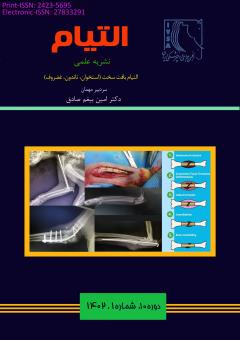دررفتگی کشکک در سگ ها
محورهای موضوعی : علوم جراحی دامپزشکی شامل جراحی های بافت های سخت و نرم
علیرضا شیخ زاده
1
,
امین بیغم صادق
2
![]()
1 - دانشجو، گروه علوم درمانگاهی، دانشکده دامپزشکی، دانشگاه شیراز، شیراز، ایران
2 - استاد، گروه علوم درمانگاهی، دانشکده دامپزشکی، دانشگاه شیراز، شیراز، ایران
کلید واژه: دررفتگی کشکک به سمت میانی, دررفتگی کشکک به سمت جانبی, زانو, اندام خلفی, سگ, نژاد کوچک,
چکیده مقاله :
دررفتگی کشکک یکی از مشکلات رایج ارتوپدی در سگ هاست. هم سگ های نژاد کوچک و هم سگ های نژاد بزرگ می توانند درگیر بشوند، همچنین این بیماری در گربه ها نیز ممکن است دیده بشود. دررفتگی به سمت میانی نسبت به سمت جانبی رایج تر است و معمولا در سگ های نژاد کوچک تشخیص داده می شود. دررفتگی کشکک بر اساس شدت تغییرات اتفاق افتاده، به 4 گرید مختلف تقسیم بندی می شود. دررفتگی کشکک یک اختلال مادرزادی یا وابسته به رشد است، اما می تواند بطور ثانویه در اثر ضربه ( که منجر به پاره شدن یا کش آمدن کپسول مفصل و بافت های اطرافی و بی ثباتی رانی-کشککی حاصله) نیز رخ بدهد. تشخیص بر اساس شواهد بالینی بی ثباتی کشکک است، اما تصویربرداری تشخیصی نیز برای بررسی میزان بدشکلی های استخوانی و همچنین تعیین مناسب ترین روش درمان نیاز است. علائم بالینی می تواند از یک سگ تا سگ دیگر تفاوت داشته باشد و صرفا تا حدودی مرتبط با میزان بد شکلی های استخوانی همزمان می باشد. لنگش می تواند پیوسته یا متناوب باشد. درمان جراحی شامل تکنیک هایی است که در بافت نرم و بافت استخوانی قابل انجام می باشد، اما در بیشتر کیس ها ترکیبی از هر دو روش برای اصلاح دررفتگی بکار برده می گردد. نرخ مشکلات بعد از عمل معمولا پایین است و از جمله متداول ترین مشکلات بعد از عمل دررفتگی مجدد و همچنین مشکلات مربوط به ایمپلنت می باشد. پیش آگهی درمان بطور کلی مطلوب است و در عمده بیماران، بعد از عمل، اندام به فعالیت طبیعی خود باز میگردد. این مقاله به توصیف دررفتگی کشکک در سگ ها، شامل تظاهر بالینی، تشخیص و گزینه های درمانی موجود می پردازد.
Patellar luxation is a common orthopedic problem in dogs. Both large and small breed dogs may be affected; the disease may be seen in cats as well. Medial luxation is more common than lateral luxation and is usually diagnosed in dogs of small breed. patellar luxation based on severity of occurred changes divided to 4 different grades. Patellar luxation is a congenital/developmental disorder, but it could be secondary to traumatic accident causing tearing or stretching of the joint capsule and fascia, leading to femoropatellar instability. Diagnosis is based on clinical evidence of patellar instability; however, diagnostic imaging is required to assess the amount of skeletal deformity and then the most appropriate method of treatment. Clinical signs of dogs with patellar luxation can vary from animal to animal and are only partially related to the degree of concomitant skeletal deformities. Lameness may be intermittent or continuous, and usually is a mild-to-moderate weight bearing lameness with occasional lifting of the limb. Concurrent rupture of the CrCL has been reported in a study in 41% of the stifle joints of dogs with medial patellar luxation. Surgical options include both soft tissue and osseous techniques, however, in most of the cases, a combination of more procedures is used to achieve the correction of the luxation. Complication rate is generally low and the most common complications include reluxation and implant-associated complications. Prognosis is generally favorable, with most of the dogs returning to normal limb function. This article describes patellar luxation features in dogs, including clinical presentation, diagnosis, and treatment options available
1. Nunamaker DM. Textbook of Small Animal Orthopaedics. Lippincott Williams & Wilkins; 1985.
2.Abercromby RH, May C, Turner BM, Carmichael S, Ness MG. A Survey of Orthopaedic Conditions in Small Animal Veterinary Practice in Britain. Veterinary and Comparative Orthopaedics and Traumatology. 1996;9(2):43-2.
3. DeAngelis M. Patellar Luxation in Dogs. Veterinary Clinics of North America. 1971;1(3):403-15.
4. Linney WR, Hammer DL, Shott S. Surgical treatment of medial patellar luxation without femoral trochlear groove deepening procedures in dogs: 91 cases (1998–2009). Journal of the American Veterinary Medical Association. 2011;238(9):1168-72.
5. Roush JK. Canine Patellar Luxation. Veterinary Clinics of North America: Small Animal Practice. 1993;23(4):855-68.
6. Bosio F, Bufalari A, Peirone B, Petazzoni M, Vezzoni A. Prevalence, treatment and outcome of patellar luxation in dogs in Italy. Veterinary and Comparative Orthopaedics and Traumatology. 2017;30(5):364-70.
7. Alam MR, Lee JI, Kang HS, Kim IS, Park SY, Lee KC, Kim NS. Frequency and distribution of patellar luxation in dogs. Veterinary and Comparative Orthopaedics and Traumatology. 2007;20(1):59-4.
8. LaFond E, Breur GJ, Austin CC. Breed Susceptibility for Developmental Orthopedic Diseases in Dogs. Journal of the American Animal Hospital Association. 2002;38(5):467-7.
9. L’Eplattenier H, Montavon P. Patellar luxation in dogs and cats: management and prevention. Compendium. 2002;24(4):292-300.
10. Dona FD, Della Valle G, Balestriere C, Lamagna B, Meomartino L, Napoleone G, Lamagna F, Fatone G. Lateral patellar luxation in nine small breed dogs. Open Veterinary Journal. 2017;6(3):255.
11. Harasen G. Patellar luxation: pathogenesis and surgical correction. The Canadian Veterinary Journal. 2006;47(10):1037.
12. Priester WA. Sex, size, and breed as risk factors in canine patellar dislocation. Journal of the American Veterinary Medical Association. 1972;160(5):740-2.
13. Alam MR, Lee JI, Kang HS, et al. Frequency and distribution of patellar luxation in dogs. 134 cases (2000 to 2005). Vet Comp Orthop Traumatol. 2007;20(1):59–64.
14. O’Neill DG, Meeson RL, Sheridan A, Church DB, Brodbelt DC. The epidemiology of patellar luxation in dogs attending primary-care veterinary practices in England. Canine Genetics and Epidemiology. 2016;3(1).
15. 1 Vidoni B, Sommerfeld-Stur I, Eisenmenger E. Diagnostic and genetic aspects of patellar luxation in small and miniature breed dogs in Austria. Companion Animal Practice. 2006;16:149.


